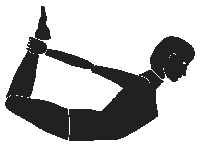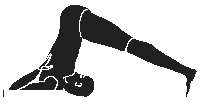Introduction

In this form of hair loss, the hair can become thin over the entire scalp. A lot of things can cause excessive hair loss. For e.g. stress, illness, surgery, hormonal imbalance, hair or scalp infection, some medicines (like anticoagulants used for gout, chemotherapy, cancer), excess vitamins, birth control pills, antidepressants etc. One of the main reasons for hair loss in men is the formation of Dihydrotestosterone, a male hormone. Once formed, Dihydrotestosterone binds to the hair follicle, retards growth and cuts off blood supply to the follicle. Hormonal problems may cause hair loss. If your thyroid gland is overactive or underactive, your hair may fall out. This hair loss usually can be helped by treatment thyroid disease. Hair loss may occur if male or female hormones, known as androgens and estrogens, are out of balance.
Baldness and Yoga

YOGA POSES FOR BALDNESS - HAIR LOSS
Camel Pose
Ushtra means a camel. In this asana almost all the limbs of the body are arched like those of a camel. So it is called Ushtrasana.The Camel Yoga Pose helps stretch the front of the body including the chest, abdomen, and quadriceps. It improves spinal flexibility. It is best to practice it later in your asana routine after most of the muscles are limber and you have worked the back and shoulders.Downward-Facing Dog Pose
This pose controls breathing and constricts the chest and the entire body, adding flexibility to the spine. To come into this posture, position yourself on the ground on all fours, knees under hips and hands in front of your shoulders. Inhale, bringing head and tailbone slowly upwards. Exhaling, rise from the floor with your knees bent. Straighten your arms and legs, but keep your head lowered. Hold this pose for 30-60 seconds, continuing to inhale and exhale throughout.Cobra Pose
The basic movement of the cobra pose is to arch the spine backward as you lie on the floor on your stomach. While a great stretch, it poses special concerns for people with back pain.Shoulder Stand Pose
This yoga pose is for thyroid & parathyroid glands, located in the neck region, since due to the firm chin-lock in sarvangasana their is increased fresh blood supply to this glands. This ample supply of blood increases their working efficiency. These glands regulate protein, carbohydrate and fat metabolism, affecting how human cells use energetic compounds.YOGA ASANAS FOR BALDNESS - HAIR LOSS
MAKARASANA

Steps
- Start lying on belly, feet turned out.
- Bend your elbows, holding onto opposite elbows and placing your elbows on the floor forward from your shoulders.
- Drop your forehead to your forearms. Your chest should be off the floor and your head should comfortably reach your forearms, while your neck and shoulders remain comfortable. Make any adjustments to the position of your arms that you need to make.
- Begin breathing deeply into your belly, breathing through your nose. Your belly should press against the floor as you inhale and relax as you exhale. This provides a gentle massage to your internal organs, helps strengthen your diaphragm and helps to stimulate circulation throughout your torso.
- Stay in this position for 8-10 long, slow belly breaths.
- Release your elbows and press back to child's pose or come up to sitting.
SARVANGASANA

Steps
- Lie on your back with legs and arms straight, feet together and palms on the floor beside your body. While exhaling, raise your legs slowly upto 90 and then the whole body and the rest your weight on the arms so that the chin touches the jugular notch.
- Bring the arms and hands to support your body at the hip region (fingers at the back and thumb in front of the body). The entire weight of your body rests on the head, neck and shoulders while the arms are used for balancing.
- Keep the trunk, legs and hips in a straight line and as vertical as possible Focus your eyes on your toes, with your chin pressed against the chest. Retain the posture for one for three minutes.
- While exhaling, return to the lying position by bringing the leg backward and releasing the hands and the palms.
MATSYASANA
This asana is very useful for persons suffering from chronic cough, bronchial asthma, congestion, infected tonsils and other respiratory disorders. Problems relating to thyroid and para-thyroid glands can also be overcome be done to derive the full of Sarvangasana.it is recommended that you breath while holding it for between two and four minutes.
Steps
- Sit with your legs fully stretched out. Bend each leg at the knees and place your feet on the other hip joint. Both the heels are adjusted in such a way that each presses the adjacent portion of the abdomen. This forms the foot-lock in a sitting position.
- Bend backwards and, exhaling, rest your weight on the elbows. Push your neck backwards and slightly rise the hip upward thus making an arch of the spine.
- Then, by making hooks of the forefingers, hold your toes on the corresponding side without crossing your arms.This posture should be maintained for some time with slow and deep breathing.
- For reverting to the original position, release the foot-lock and return to the supine position by lowering the arch.
DHANURASANA

Steps
- Take prone lying position, legs together, hands straight by the side of the thighs, chin resting on the ground. Fold the legs at the knees and bring them on the thighs. Knees must remain together.
- Bring your hands backward and hold the toes of respective legs from the thumb and forefinger of the respective hands.
- Raise your legs a little up and simultaneously raise your head and chest.
- Holding the toes pull the legs towards ears and bring the toes near the ear. Gaze in front.
- While returning to this original position, loosen your hands, take legs backward, let the thighs touch the ground, leave the toes and ultimately bring the legs and hand to the first position
SHIRSHASANA

This asana is helpful in cases of dyspepsia and constipation. It improves the functions of the reproductive glands and heart muscles and is of great advantage in checking wet dreams.
Steps
- Sit in a kneeling position with the buttocks resting on the heels of the feet.
- Lean forward and place the forearms on the floor in front while keeping the elbows about shoulder distance apart. Interlock the fingers of both hands.
- Place the top of the head flat on the floor with the back of the head pressed against the inside of the interlocked fingers.
- Placing the tips of the toes firmly on the floor while lifting the heels, raise the knees off the floor.
- Hold for the duration of the held inhaled breath. When you can't hold the breath comfortable any longer, slowly exhale and return the back to the floor, slide the legs out straight returning to the shava-asana.
USTRASANA

Steps
- Sit in Vajrasana i.e. squat on the floor, toes pointing backwards.
- Now, stand on your knees with arms at the sides.
- Spread knees about half a foot apart.
- Bend your body backwards and hold your ankles with both hands so that you end up looking at the ceiling.
- Push the abdomen forward as much as possible keeping the thighs vertical.
- Return to the starting position, slowly releasing the hands from the ankles, one at a time.
- Return to Vajrasana and relax breathing normally.
- As with all yoga, make sure to monitor and steady your breathing.
- Avoid this pose if you have any serious injury to your lower back or neck.
HALASANA

Steps
- Lie on your back inhale to your fullest and lift your legs and trunk first to 30 degree, then 60 degree and finally 90 degree just as in sarvangasana, then take your legs back of your head making it 120 degree and beyond, this process should be done while exhalaling.
- Now rest the toes on the ground behind the head and breath normally, you can use hands on the back for support but ideally both in sarvangasana and halasana hands should be on flooe, palms touching the floor.
- When acquiring the posture of halasana the legs should be at 30 degree from the floor.
- Same process is done in reverse order while returning to normal position. .
|
Diseases Related to Aries Zodaic Sign
| ||


